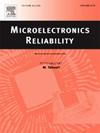不同栅氧化层厚度碳化硅mosfet的动态和静态辐射损伤
IF 1.9
4区 工程技术
Q3 ENGINEERING, ELECTRICAL & ELECTRONIC
引用次数: 0
摘要
辐射效应是SiC mosfet在空间和核应用中的关键问题。氧化层厚度是影响SiC mosfet抗辐射性能的重要因素。栅氧化层的厚度会影响硅场效应管的辐射效应,研究不同的栅氧化层厚度的影响(托克斯)碳化硅的总剂量辐射损伤场效电晶体,在本文中,我们将演示两种不同的影响与50和70 nm托克斯SiC的动态和静态特性垂直双扩散MOS (VDMOS)γ辐照后,和总剂量效应辐射损伤机制是通过实验和模拟显示,找出了导致设备静态参数和动态特性退化的主要原因。结果表明,栅极氧化层厚度也会显著影响SiC mosfet的辐射效应,在总电离剂量(TID)下,越厚的栅极氧化层会积累更多的捕获电荷,从而导致更严重的性能下降。研究结果可为SiC mosfet栅极氧化层厚度的优化及抗TID辐射的应用提供依据。本文章由计算机程序翻译,如有差异,请以英文原文为准。
The dynamic and static radiation damage of silicon carbide MOSFETs with different gate oxide thickness
Radiation effects are a critical issue for SiC MOSFETs in space and nuclear applications. The thickness of the oxide layer is an important factor affecting the radiation resistance of SiC MOSFETs. The thickness of the gate oxide layer will affect the radiation effects of Si MOSFETs, to study the effects of different gate oxide thickness (tox) on the total dose radiation damage of SiC MOSFETs, In this paper, we demonstrate the effects of two different tox with 50 nm and 70 nm on the dynamic and static characteristics of SiC vertical double-diffused MOS (VDMOS) after gamma irradiation, and the total dose effect radiation damage mechanism is revealed through experiments and simulations, the main reasons for the degradation of static parameters and dynamic characteristics of the devices are identified. The results indicate that gate oxide thickness will also impact the radiation effects of SiC MOSFETs significantly, a thicker gate oxide layer accumulates more captured charge under the total ionizing dose (TID), thus producing a more severe performance degradation. The results can provide a basis for the optimization of the gate oxide thickness and the application of TID radiation-resistant of SiC MOSFETs.
求助全文
通过发布文献求助,成功后即可免费获取论文全文。
去求助
来源期刊

Microelectronics Reliability
工程技术-工程:电子与电气
CiteScore
3.30
自引率
12.50%
发文量
342
审稿时长
68 days
期刊介绍:
Microelectronics Reliability, is dedicated to disseminating the latest research results and related information on the reliability of microelectronic devices, circuits and systems, from materials, process and manufacturing, to design, testing and operation. The coverage of the journal includes the following topics: measurement, understanding and analysis; evaluation and prediction; modelling and simulation; methodologies and mitigation. Papers which combine reliability with other important areas of microelectronics engineering, such as design, fabrication, integration, testing, and field operation will also be welcome, and practical papers reporting case studies in the field and specific application domains are particularly encouraged.
Most accepted papers will be published as Research Papers, describing significant advances and completed work. Papers reviewing important developing topics of general interest may be accepted for publication as Review Papers. Urgent communications of a more preliminary nature and short reports on completed practical work of current interest may be considered for publication as Research Notes. All contributions are subject to peer review by leading experts in the field.
 求助内容:
求助内容: 应助结果提醒方式:
应助结果提醒方式:


